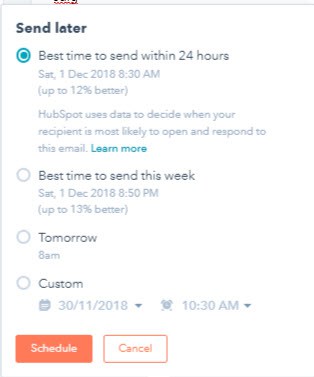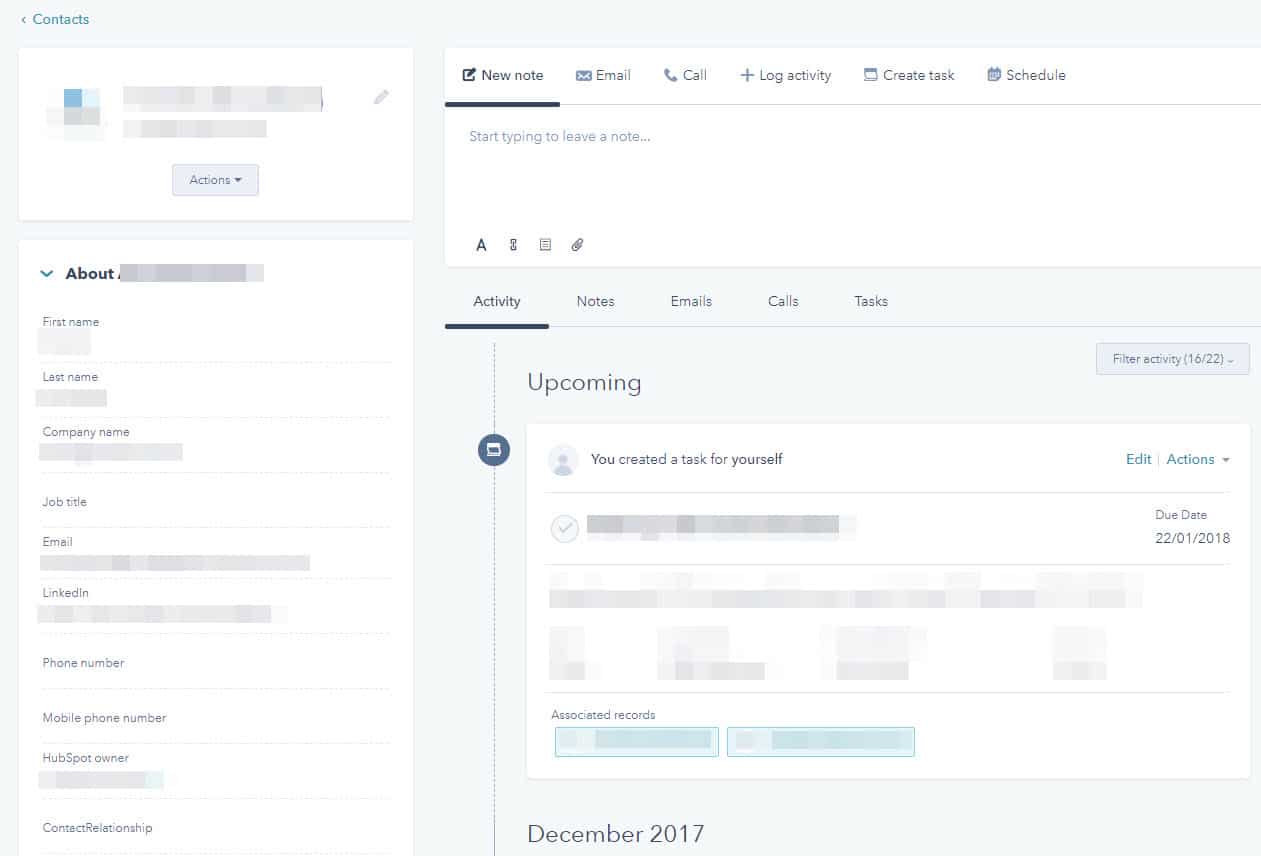As noted in the title, this HubSpot CRM 2018 review is by an actual user – it’s not one of those robo comparisons that are becoming so common.
In late 2018 HubSpot did a pretty major revamp of their pricing and added plenty of new features to the system. This review was updated in December 2018 to take account of those changes.
We’ve been using the HubSpot Marketing and CRM system for more than a year and the more we use it, and the more we uncovered little features here and there, the more we like it.
Links to Key Topics
- What is HubSpot Sales?
- Summary of Price Points
- HubSpot CRM Review Summary
- Key HubSpot CRM Advantages
- Key HubSpot CRM Disadvantages
- Email, Email Sync and Integration (Outlook and Gmail, Free)
- Contact and Company Management (Free)
- Contact and Company Insights (Free)
- Deals (Free)
- Tasks (Free)
- Prospects (Starter)
- Meetings (Free)
- Live Chat (Starter)
- Sequences (Starter)
- Multiple Deal Pipelines (Professional)
- Sales Automation (Professional)
- Custom Reporting (Professional)
- Predictive Lead Scoring (Enterprise)
- Overall, How Good is HubSpot CRM?
What is HubSpot Sales?
The HubSpot technology stack has three elements: Marketing, Sales, Service.
In this review I’m looking at the Sales element of the HubSpot CRM. It provides sales tools for managing contact, company and deal data and processes.
While there is a free tier, there are a series of feature upgrades that are chargeable. Although, in fairness, if you’re looking for a simple sales CRM, the free version is very functional and many businesses will not need to upgrade to a paid version.
Summary of Price Points
There are four levels of HubSpot Sales pricing:
Free
Yes, this is really free and gives you a very usable CRM for very small (and not to small) businesses.
With the free version you can load up to 1,000,000 contacts, companies and deals. Plenty enough for 99.99% of businesses.
It also includes HubSpot Marketing Free: this is a pretty feature packed starting package of email marketing functions and includes – Lead analytics, lead flows and lead capture forms.
There’s a lot in the free package.
Sales Starter
This mid-priced kit provides some nice tools, particularly, Prospects and Email Sequences, that are worth the investment even for smaller firms.
Sales Professional
This version contains enhanced features e.g. 1:1 video creation, smart send times, sales automate, etc that can be very effective for small-medium businesses.
Sales Enterprise
This is an enterprise ready tool with features such as predictive lead scoring, single sign on, playbooks, etc, that are great for larger businesses.
HubSpot CRM Review Summary
Over the years I’ve used lots of different CRM packages and SaaS applications. Until recently we were using the Zoho CRM but there plenty of others on the market.
Many of the feature are not truly unique to the HubSpot CRM and are available in other packages, both CRM and non-CRM.
However, the nice part of using the HubSpot CRM is the features are captured in one package without the need to integrate and buy multiple, off the shelf, point solutions.
“Meetings” (shared calendar direct booking) are just there, so are Live Chat (web chat) and Prospects (tracking which companies visit your website).
I’ve found that the more I use it the more I find little HubSpot CRM hacks and features that save time every day and just make it easier to run the sales process.
In this HubSpot CRM review I’m not going to run through every feature of the system in detail – for that you can see the HubSpot sales page.
I’m going to point out the parts I use, and don’t use, and where they make a real difference in our business – positive or negative.
Key HubSpot CRM Advantages
The critical advantages of the HubSpot CRM include:
- Single system, no integrating required
- Great level of free functionality, including Meetings and email tracking
- Some nice higher-level features including: Prospects, Email Sequences, Sales Automation, and Predictive Lead Scoring
Key HubSpot CRM Disadvantages
Honestly, there are not any real major disadvantages to the product.
I wish they would lay out the contact and company properties across the page rather than vertically down the left-hand side of the contact but that’s minor. More on this later.
Email, Email Sync and Integration (Outlook and Gmail, Free)
Giving HubSpot access to your email account unlocks a ton of useful features.
The ability to send emails from within the platform is not unique to the HubSpot CRM but it is implemented very nicely.
Sending emails is well executed and I’ve found myself using it more and more as the editor is functional enough for simple sales emails. It also includes the ability to send BCCs and CCs, reply directly, etc.
The support for signature blocks is strong and easy to use.
The result is an email creation process strong enough to be used to send emails everyday.
Emails can also be associated with contacts, companies and deals. This is a very useful in B2B sales where multiple people are often involved in a specific deal.
Email Tracking
Emails sent from within the HubSpot CRM are tracked in the same way as typical marketing emails. This means you know, mostly, when they have been opened, if the recipient has viewed attachments and if they have clicked through on links. You can choose to be alerted in real time when these events occur.
The use case here is very strong: knowing the customer has opened your proposal document allows you to call them shortly afterward to ask what they thought, knowing your proposal is top of mind and they are probably at their desk able to take a call.
You may want to careful with this feature as it can be a bit Big Brother creepy for your prospect.
Document tracking
Documents can be loaded into HubSpot and shared with sales staff.
Even nicer, is the ability track when documents are opened by a recipient. You can even lock down a document in such a way as to require an email address from anyone other than the email recipient, allowing you to track everyone who views the document at a company.
Outlook Integration
In the past this was so poor as to be un-usable and I’ve uninstalled it a couple of times.
Not in terms of features but implementation. The plug-in would slow down Outlook for every, email, you, ever, create.
However, a recent update (3.0+) seems to have vastly improved this functionality and responsiveness. You should try it out to determine how well it works for you but I like it now.
The features are moderately useful and include a quick link to the record in the CRM, details about the person, company, deals, action etc, in the email pane itself. You can also add contacts directly to the database from within the email. It’s pretty nice.
Snippets
These are short saved texts that can be dropped into emails and save on typing. Moderately useful.
In the past I’ve used Breevy and will continue to do so at it works across all platform, not just in the CRM. However, if you have a large sales team it might be useful to coordinate these for all staff members.
Emails sent/received form your email turn up in the Contact record
When you give HubSpot access to your email box it monitors incoming and outgoing email.
Using the contact email address as the link, HubSpot copies the email into the contact record when you send or receive an email. So, you can see all communications with the contact from either your email or CRM system.
Emails sent within HubSpot are copied to your Email
If you’re using sending one off emails or emails in Sequences, HubSpot will copy them to your Sent mail box. This makes it easy to search for a specific email that you might have sent.
Smart Send Times (Professional)
This features lets you delay sending of the email to a time of your choosing or when HubSpot thinks it is most likely to be opened. This is great when you’re working through a task list late at night or on the weekend. You really want that email to turn up a time that the person is most likely to read it, not at 10pm on Sunday night.
Contact and Company Management (Free)
The base contact management is straightforward and similar to other platforms.
The system has the concept of both contacts and companies. You can create a hierarchy of companies to account for divisions, brands and different company ownership structures.
There are many standard fields and the ability to add new fields (called Properties) to exactly match your business needs.
None of this is unique to HubSpot CRM.
As referenced above, the only annoying part is the way the data is laid out on the page.
Unlike other systems where the data about the contact is laid out across the page, the HubSpot CRM lists the contact data vertically down the left-hand side of the page. While you can re-order the data, it means you can only have a few contact fields “above the fold”. It can be annoying to always be scrolling down to find details you want.
Contact and Company Insights (Free)
Based on the company domain (URL) HubSpot CRM provides a nice set of company data including LinkedIn company page, estimated revenue, staffing, phone numbers and other pertinent details.
While not that hard to collect elsewhere, having it automatically added to the Company record is a nice feature.
Deals (Free)
Deals are the sales opportunity object.
These have much of the information you would expect: related contacts and companies, size, deal stage, etc. These are also extendable, i.e. you can add your own fields.
The reporting these is also quite nice with a Kanban style interface available. Moving deals between stages is as easy as dragging them across the page.
Deals are similar to many other systems, but you have the ability to incorporate them into automation work-flows (called Sales Automation – Professional – see below) which can be useful to automatically open, allocate and manage deals as part of your sales process flow.
Tasks (Free)
Tasks themselves are not unique but there are some keystroke saving features such as the ability to automatically create email alerts when tasks are due and automatically create tasks when you send an email or book a meeting.
The automatic nature of setting these up, means you’re more likely to actually do it.
Tasks have a, not well explained, killer feature that allows you to assign each task to a Queue, e.g. phone calls, high value, low value, etc. Then with a single click you can start the queue processing and HubSpot will show you the contract record for each person, allow you to execute the task and move on with one-click.
See this post on HubSpot sales hacks for a video of how it works.
Prospects (Starter)
The HubSpot Prospects feature uses reverse look up of the IP address the visitor’s PC to suggest where the person works, even if they don’t fill in a form.
Sadly, the Prospects feature was significantly downgraded in it’s functionality in late 2018 due to changes in data privacy laws.
In the past, clicking on the domain name in the report provides details of all the pages people from the company have viewed, with details of how they arrived at the page (source). Now all you see is the number of pages viewed by that company but no details of which pages. If your site contains a range of services or products, knowing which pages they looked at is crucial to knowing who to target at the account.
In the past we used this feature all time but we hardly ever bother now as the data is nearly impossible to action.
Meetings (Free)
There are a range of systems you can use to enable customers to book time directly in your diary.
I’ve used Schedule Once but there are many others on the market. The HubSpot CRM version (called simply Meetings) is no better in basic function to the others but it does have one killer feature and one nice to have feature.
The killer feature is that when a prospect uses it to book time with you, they have filled in a HubSpot Form. From that point forward, you can track much more about their on-line interaction with your website.
The nice to have features is that it’s just there. No need to integrate with another on-line tool or pay another bill.
Live Chat
Once you have the code installed on your website the HubSpot CRM can also launch a Live Chat session.
Again, having this in the main package means you don’t have to purchase it elsewhere.
As with Meetings, the feature is good but not world-shaking. It gets the job done but without the custom features some targeted applications have.
On the upside, because it’s integrated into CRM it is “aware” of the people visiting your site and you can change the messaging for known and unknown people.
The one feature I would have liked to see is the ability to show the messages based on geographic location. We get a lot of traffic on this site from locations we can’t service, and I’d rather not be popping message boxes for people in locations we don’t serve.
Email Sequences (Starter)
This is one of the killer applications for this CRM. Sequences are mini, sales focused marketing campaigns that you kick-off manually by enrolling the prospect. Crucially they will automatically drop out when a prospect responds to your email.
Each sequence can include emails and task assignments which are automatically executed. They allow you to automate a large amount of routine follow-up for a prospect.
I’ve created a couple of standard follow-up processes for Prospects based on their Buyer Persona. Once initiated, they receive emails and I receive alerts on tasks (make outbound attempt, attempt to contact via LinkedIn, etc) as they are needed. The coolest part is as soon as they respond I’m notified (by their email and the system) and the sequence stops – so there is no chance of out of context messages going to prospects.
If you have a large sales team you can template the best sales processes and bring everyone up to the same speed.
Multiple Deal Pipelines (Professional)
This is the ability to have different deal stages for different types of deals. I haven’t played with this and I suspect it will only apply to quite large organisations with different product/service sales process.
Sales Automation (Professional)
In summary this allows you to automate fairly complex sales processes inside your organisation. You can for instance create and manages deal, rotate leads, create branching workflows and even alert internal staff via a Slack channels.
I use to think this was only for larger organisation but we’ve also seen it work well for smaller organisations with repeatable sales processes.
Custom Reporting (Professional)
HubSpot have really invested in the reporting side of the system in 2018. In the past it was okay but they have made substantial improvements in what and how critical sales data can be reported.
See here for a few sample HubSpot sales reports but also check out this Sales reporting hacks presentation from Daniel Bertschi at HubSpot for a great inside view on what’s really possible.
Basically, unless you have really unusual requirements you shouldn’t need to go outside the included sales reporting features.
Predictive Lead Scoring (Enterprise)
This was recently moved from Professional to the Enterprise version of the system and that makes sense as only larger organisations will be able to make effective use of it.
Designing your lead scoring scheme takes time and effort and HubSpot’s Predictive Lead Scoring process looks like it will take the difficulty out of the process.
In practice, though, you need quite a large base of customers before you can get an accurate model. These are a couple of the prerequisites:
You have at least 150 customers who existed in HubSpot for more than one day before becoming a customer (or further along in the funnel, such as Evangelist or Other) and who have submitted at least one form.
You have at least twice as many non-customer contacts (Subscriber, Lead, MQL, SQL, or Opportunity) as you do customers.
We haven’t yet passed the first of these benchmarks, so this is still on the drawing board for us.
Overall, How Good is HubSpot CRM?
It’s pretty good and the free version is great value for money for small organisations. There doesn’t seem to be another package out there that provides the same level of basic CRM features at a free price tag.
It also keeps up as your business becomes more complex. The predictive lead scoring, sales automation and Prospects features are all very worthwhile.
Lastly, maybe actions speak louder than words. We started out hedging our bets with the HubSpot CRM in that we kept our Zoho system running in the background. However, after a few months using the HubSpot system we’ve moved over 100%.








